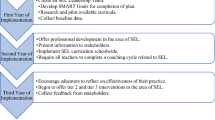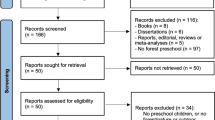Abstract
This study focused on our teaching efforts in regard to preparing preservice teachers to one day teach children about ecological concepts that many find scary or disgusting. Specifically, we examined the attitudes these preservice teachers had towards certain invertebrates. These attitudes were compared to their self-efficacy towards teaching about them. A multiple case study design was used, involving both qualitative and quantitative data. Participants were categorized as having positive, neutral, or negative attitudes towards the invertebrates and activities. Self-efficacy for participants’ perceived ability to teach these concepts were categorized as high, medium, or low. Correlations were run to examine relationships between variables of attitudes and self-efficacy. Participants demonstrated more negative than positive reactions towards the invertebrates. Positive correlations between attitudes towards invertebrates and their self-efficacy towards teaching about them were found. This indicates that if we want future teachers to be comfortable teaching about the scary and disgusting aspects of an ecosystem, we need to find ways to help them improve their attitudes towards those aspects of the outdoors.





Similar content being viewed by others
References
Albion, P. R., & Spence, K. G. (2013). Primary connections in a provincial Queensland school system: Relationships to science teaching self-efficacy and practices. International Journal of Environmental & Science Education, 8, 501–520.
Bandura, A. (1978). Self-efficacy: Toward a unifying theory of behavioral change. Advances in Behaviour Research and Therapy, 1, 139–161.
Blank, R. K. (2013). Science instructional time is declining in elementary schools: What are the implications for student achievement and closing the gap? Science Education, 97, 830–847.
Borgi, M., & Cirulli, F. (2015). Attitudes toward animals among kindergarten children: Species preferences. Anthrozoös, 28(1), 45–59.
Botella, C., Pérez-Ara, M. Á., Bretón-López, J., Quero, S., García-Palacios, A., & Baños, R. M. (2016). In vivo versus augmented reality exposure in the treatment of small animal phobia: A randomized controlled trial. PLoS One, 11(2), e0148237.
Broeren, S., Lester, K. J., Muris, P., & Field, A. P. (2011). They are afraid of the animal, so therefore I am too: Influence of peer modeling on fear beliefs and approach – Avoidance behaviors towards animals in typically developing children. Behaviour Research and Therapy, 49, 50–57.
Breuer, G. B., Schlegal, J., Kauf, P., & Rupf, R. (2015). The importance of being colorful and able to fly: Interpretation and implications of children’s statements on selected insects and other invertebrates. International Journal of Science Education, 37(16), 2664–2687.
Carr, N. (2016). An analysis of zoo visitors’ favourite and least favourite animals. Tourism Management Perspectives, 20, 70–76.
Colléony, A., Clayton, S., Couvet, D., Saint Jalme, M., & Prévot, A. (2017). Human preferences for species conservation: Animal charisma trumps endangered status. Biological Conservation, 206, 263–269.
Creswell, J. W., & Creswell, J. D. (2018). Research design: Qualitative, quantitative, and mixed methods approaches (5th ed.). Los Angeles: SAGE.
Curtis, V., & Biran, A. (2001). Dirt, disgust, and disease: Is hygiene in our genes? Perspectives in Biology and Medicine, 44(1), 17–31.
Davey, G. C. L. (2011). Disgust: The disease-avoidance emotion and its dysfunctions. Philosophical Transactions: Biological Sciences, 366(1583), 3453–3465.
Draheim, M. M., Patterson, K. W., Rockwood, L. L., Guagnano, G. A., & Parsons, E. C. M. (2013). Attitudes of college undergraduates towards coyotes (Canis latrans) in an urban landscape: Management and public outreach implications. Animals, 3, 1–18.
Drissner, J., Simonte, M., & Hille, K. (2016). Attitudes of school children in Germany and Costa Rica towards invertebrates –a comparison. Research Journal of Education, 2(3), 34–37.
Dunne, G., & Askew, C. (2013). Vicarious learning and unlearning of fear in childhood via mother and stranger models. Emotion, 13, 974–980.
Eidietis, L., Gray, S., Riggs, L., West, B., & Coffman, M. (2007). Goodbye critter jitters: Preservice teachers discover the benefits of using invertebrates to support inquiry. Science and Children, 45(1), 37–41.
Hazzah, L., Bath, A., Dolrenry, S., Dickman, A., & Frank, L. (2017). From attitudes to actions: Predictors of lion killing by Maasai warriors. PLoS One, 12(1), e0170796.
Hoehl, S., & Pauen, S. (2017). Do infants associate spiders and snakes with fearful facial expressions? Evolution and Human Behavior, 38, 404–413.
IUCN. (2017). The IUCN red list of threatened species. Version 2017-3: Summary statistics. Retrieved from http://www.iucnredlist.org/about/summary-statistics#Tables_1_2
Johns, R. A. & Pontes, R. (2019). Parks, rhetoric and environmental education: Challenges and opportunities for enhancing ecoliteracy. Journal of Outdoor and Environmental Education. https://doi.org/10.1007/s42322-019-0029-x
Kazempour, M. (2014). I can’t teach science! A case study of an elementary pre-service teacher’s intersection of science experiences, beliefs, attitude, and self-efficacy. International Journal of Environmental & Science Education, 9, 77–96.
Kellert, S. R. (1984). American attitudes toward and knowledge of animals: An update. In M. W. Fox & L. D. Mickley (Eds.), Advances in animal welfare science 1984/85 (pp. 177–213). Washington, DC: The Humane Society of the United States.
Mallan, K. M., Lipp, O. V., & Cochrane, B. (2013). Slithering snakes, angry men and out-group members: What and whom are we evolved to fear? Cognition and Emotion, 27, 1168–1180.
Meltzer, N., Bobilya, A. J., Faircloth, W. B., Mitten, D., & Chandler, R. M. (2018). The effect of an outdoor orientation program on participants’ biophilic expressions. Journal of Outdoor and Environmental Education, 21, 187–205.
Moss, A., & Esson, M. (2010). Visitor interest in zoo animals and the implications for collection planning and zoo education programmes. Zoo Biology, 29, 715–731.
Muris, P., Bodden, D., Merckelback, H., Ollendick, T. H., & King, N. (2003). Fear of the beast: A prospective study on the effects of negative information on childhood fear. Behaviour Research and Therapy, 41, 195–208.
Muris, P., Mayer, B., Huijding, J., & Konings, T. (2008). A dirty animal is a scary animal! Effects of disgust-related information on fear beliefs in children. Behaviour Research and Therapy, 46, 137–144.
Muris, P., van Zwol, L., Huijding, J., & Mayer, B. (2010). Mom told me scary things about this animal: Parents installing fear beliefs in their children via the verbal information pathway. Behaviour Research and Therapy, 48, 341–346.
Plous, S. (1993). Psychological mechanisms in the human use of animals. Journal of Social Issues, 49(1), 11–52.
Prokop, P., Özel, M., & Uşak, M. (2009). Cross-culutral comparison of student attitudes toward snakes. Society and Animals, 17, 224–240.
Prokop, P., Tolarovičová, A., Camerik, A. M., & Peterková, V. (2010). High school students’ attitudes towards spiders: A cross-cultural comparison. International Journal of Science Education, 32, 1665–1688.
Randler, C., Hummel, E., & Prokop, P. (2012). Practical work at school reduces disgust and fear of unpopular animals. Society & Animals, 20, 61–74.
Schonfelder, M. L., & Bogner, F. X. (2017). Individual perception of bees: Between perceived danger and willingness to protect. PLoS One, 12(6), e0180168.
Sia, A. P. (1992, October). Preservice elementary teachers’ perceived efficacy in teaching environmental education: a preliminary study. Paper presented at the annual meeting of the ECO-ED North American Association for Environmental Education, Toronto, Ontario, Canada.
Silva, A., & Minor, E. S. (2017). Adolescents’ experience and knowledge of, and attitudes toward, bees: Implications and recommendations for conservation. Anthrozoös, 30(1), 19–32.
Sowder, M., & Harward, S. (2011). Time for science? A study on the use of instructional time for teaching science at the elementary level. Journal of the Utah Academy of Sciences, Arts, & Letters, 88, 186–203.
Theimer, S., & Ernst, J. (2012). Fostering “connectedness to nature” through U.S. Fish and Wildlife Service education and outreach programming: A qualitative evaluation. Applied Environmental Education& Communication, 11(2), 79–87.
Tomažič, I., Pihler, N., & Strgar, J. (2017). Pre-service biology teachers’ reported fear and disgust of animals and their willingness to incorporate live animals into their teaching trhough study years. Journal of Baltic Science Education, 16(3), 337–349.
Trauth-Nare, A. (2017). Influence of an intensive, field-based life science course on preservice teachers’ self-efficacy for environmental science teaching. Journal of Science Teacher Education, 26(5), 497–519.
Wagler, R. (2010). The association between preservice elementary teacher animal attitude and the likelihood of animal incorporation in future science curriculum. International Journal of Environmental & Science Education, 5(3), 353–375.
Wagler, R., & Wagler, A. (2011). Arthropods: Attitudes and incorporation in preservice elementary teachers. International Journal of Environmental and Science Education, 6(3), 229–250.
Wagler, R., & Wagler, A. (2015). Assessing the attitudes and beliefs of preservice middle school science teachers toward biologically diverse animals. International Journal of Environmental and Science Education, 10, 271–286.
Whitworth, A. W. (2012). An investigation into the determining factors of zoo visitor attendances in UK zoos. PLoS One, 7(1), e29839.
Yin, R. K. (2014). Case study research: Designs and methods (5th ed.). Los Angeles: SAGE.
Author information
Authors and Affiliations
Corresponding author
Ethics declarations
Conflicts of interest
On behalf of all authors, the corresponding author states that there is no conflict of interest.
Ethical approval
This research was unfunded. It gained IRB approval. Participants provided consent.
Additional information
Publisher’s note
Springer Nature remains neutral with regard to jurisdictional claims in published maps and institutional affiliations.
Rights and permissions
About this article
Cite this article
Nageotte, N., Buck, G. “I Gotta Touch that?” Attitudes and Self-Efficacy of Pre-Service Teachers Regarding Scary or Disgusting Science. Journal of Outdoor and Environmental Education 23, 173–190 (2020). https://doi.org/10.1007/s42322-020-00054-7
Published:
Issue Date:
DOI: https://doi.org/10.1007/s42322-020-00054-7




